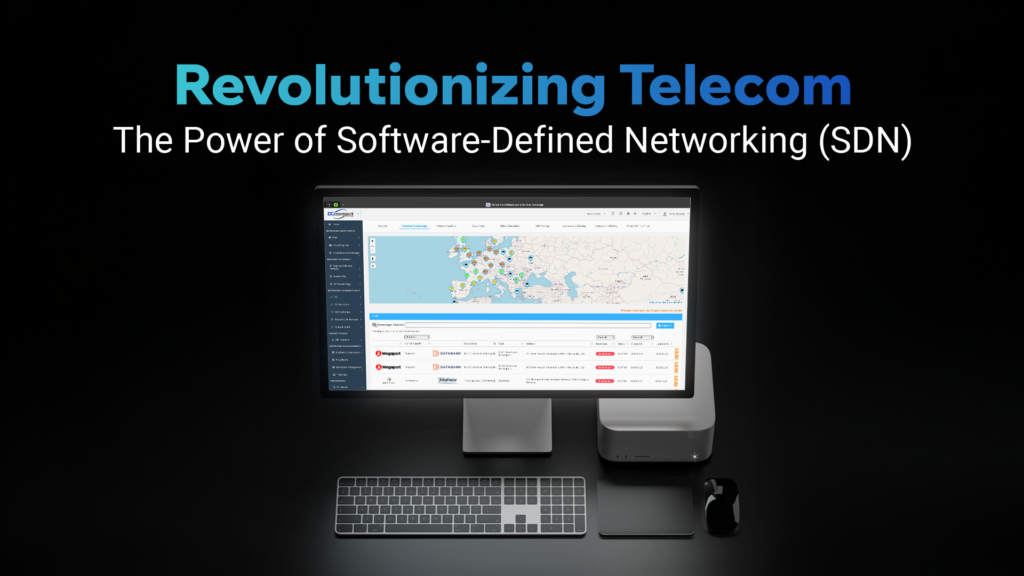
The Power of SDN
SDN stands for Software-Defined Networking, an architecture that separates the network’s control plane from the data plane. Traditionally, networks were hardware-centric, with the control logic embedded into routers and switches. SDN changes this paradigm by introducing a software-based controller that centrally manages network resources.
The flexibility of SDN allows for dynamic control, improved scalability, and more efficient resource management, which are essential for businesses navigating the ever-growing digital landscape.
How Does SDN Work?
To understand the power of SDN, it’s important to break down how it works.
- Control Plane: Manages decision-making and directs data traffic. In SDN, this is separated from the hardware and handled by a centralized software controller.
- Data Plane: Executes the forwarding of packets across the network, following the policies defined by the control plane.
- Centralized Controller: A software entity that communicates with devices using open standards like OpenFlow, allowing dynamic and programmatic control over the entire network.
The separation of these components enables network administrators to program and control the network dynamically, reducing manual intervention and operational complexity.
Benefits of SDN
Centralized Network Management
One of the biggest advantages of SDN is centralized management. By using a centralized controller, organizations can monitor, configure, and manage their entire network from a single interface. This improves efficiency and reduces the burden of managing each device individually.
Scalability and Flexibility
Networks today must handle growing workloads, increasing devices, and higher data traffic. SDN enables rapid scaling by decoupling the control logic from hardware, allowing administrators to adapt the network in real-time based on changing demands.
Improved Security
The power of SDN extends to security, as centralized control allows for:
- Real-time monitoring of traffic flows
- Implementation of unified security policies
- Rapid threat detection and mitigation
By centralizing security controls, organizations can respond faster to potential attacks and anomalies.
Cost Efficiency
SDN reduces the reliance on expensive proprietary hardware. Instead, it enables the use of generic, low-cost devices that can be centrally managed through software. This reduces capital expenditure (CAPEX) and operational expenditure (OPEX).
Automation and Programmability
The ability to programmatically control the network through APIs (Application Programming Interfaces) allows for automation of routine tasks. This includes traffic rerouting, resource allocation, and policy enforcement, reducing manual errors and improving productivity.
SDN in Cloud Computing
Cloud computing and SDN complement each other seamlessly. The flexibility and scalability of SDN make it the perfect solution for managing virtualized environments and multi-cloud infrastructures. Cloud providers benefit from:
- Centralized orchestration
- Dynamic resource allocation
- On-demand scalability
SDN ensures that cloud workloads are balanced, secure, and efficiently managed, contributing to optimized cloud performance.
The Role of SDN in IoT
With the explosive growth of IoT devices, networks must adapt to accommodate massive data volumes and connected endpoints. SDN provides a robust solution for managing IoT networks by:
- Enhancing traffic prioritization for time-sensitive IoT applications
- Enabling real-time analytics and monitoring
- Securing IoT ecosystems with centralized policy enforcement
SDN’s dynamic control ensures IoT networks remain agile, secure, and high-performing.
Key Components of SDN Architecture
SDN consists of the following core components:
SDN Controller
The brain of the SDN architecture, the controller manages and directs the network traffic, ensuring smooth operations.
Northbound APIs
Northbound APIs allow communication between the SDN controller and applications. These APIs enable programmability and integration with various tools and platforms.
Southbound APIs
Southbound APIs, such as OpenFlow, allow the SDN controller to communicate with network devices like routers and switches.
Data Plane Devices
Switches, routers, and other hardware that forward data packets based on policies defined by the controller.
OpenFlow and SDN
OpenFlow is a critical protocol in SDN that enables communication between the SDN controller and the underlying network devices. By using OpenFlow, SDN can programmatically direct traffic flow and enable efficient network management.
Challenges of Traditional Networking
To fully appreciate the power of SDN, it’s essential to understand the limitations of traditional networking:
- Manual Configurations: Complex and time-consuming setups
- Limited Scalability: Struggles with dynamic workloads and rapid changes
- Vendor Lock-In: Dependence on proprietary hardware solutions
- Lack of Automation: Increased human errors and inefficiency
SDN overcomes these challenges by introducing automation, flexibility, and software-driven control.
Why Businesses Are Moving Toward SDN
Organizations are increasingly adopting SDN due to:
- Faster provisioning of resources
- Improved performance and flexibility
- Reduced operational costs
- Enhanced security and compliance
The ability to adapt networks to business needs dynamically makes SDN an ideal choice for modern enterprises.
SDN Use Cases Across Industries
Data Centers
SDN revolutionizes data center networks by enabling dynamic resource allocation, optimizing server-to-server communication, and ensuring high availability.
Telecommunications
Telecom providers use SDN to deliver better Quality of Service (QoS), manage traffic efficiently, and enable 5G deployments.
Enterprise Networks
Enterprises leverage SDN for enhanced security, automation, and improved bandwidth management.
Healthcare
SDN facilitates secure and efficient transmission of patient data, ensuring compliance with data protection regulations.
SDN and Network Virtualization
Network virtualization, enabled by SDN, creates virtual networks that are decoupled from the physical infrastructure. This provides businesses with:
- Flexible network configurations
- Faster deployment of services
- Better resource utilization
The Future of SDN
The future of networking is driven by SDN and emerging technologies like AI and machine learning. These innovations will:
- Automate network optimization
- Enhance predictive analytics for fault detection
- Improve security with AI-driven threat responses
As networks grow in complexity, SDN will play a critical role in ensuring adaptability, performance, and security.



